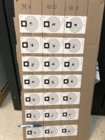First off this is just my opinion based on the last 4 years of pretty active competition and preparation for them. If you want scientific evidence fund a study with a scientist.
I've went thru over 20 barrels in the last few years. Won several yard ages and shot a fair amount of teen aggs and grand aggs in competition. So take this as you will.
Really doesn't matter to me if you agree or believe it or not
Some barrels show more horizontal with seating depth than others.
This could be coming from multiple things. I don't have an opinion on why it happens it does
I am talking about tuning at short range with a rifle and cartridge capable of extreme accuracy. If yours is not you may not be able to see this happen. If you do not tune on a single piece of paper it is harder to see and gets lost in the noise.
I will also say this was an exceptional barrel so it is easy to see the horizontal in the first couple test strings then you see it go away
The 29gr charge was just to hot a load for that day it just scattered and pitched shots out of the group at all seating depths
Take it for what you will. I would recommend not just dismissing this without doing some testing of your own
I agree 100% that seating depths are actually more important than powder charges. As you can see by the target below that when you arrive at the perfect seating depth the powder charge is less relevant.
This is a 3 shot group test with 3 different powder charges and multiple seating depths..... I generally shoot 5 shot groups but this test is mainly to get you where you want be quick. Look at seating depth 2.230 and you can see that they all group very well with 3 totally different powder charges.
Just my two cents.
Darrin











